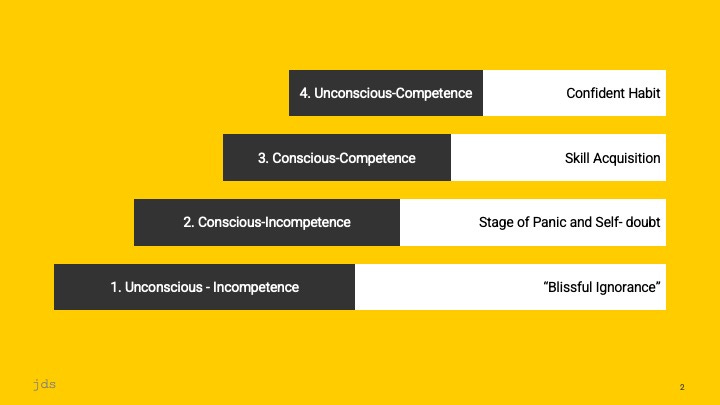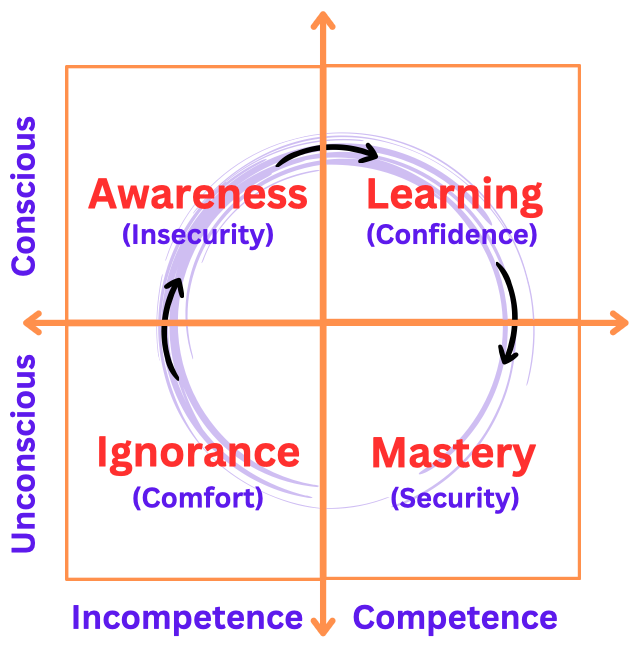When striving to be “unconscious” serves you
A model for approaching mastery in your communication
Over the past several weeks, I’ve encountered instances where speakers I observed were “doing all the right things” yet did not feel quite in command of the room or did not connect with the audience. I experienced this with talented undergrads at a Emory’s Goizueta Business School and senior leaders at a client. In both cases, the speakers were competent at what they were doing but perhaps trying too hard to “get it right” or be competent as a presenter.
These experiences reminded me of a framework developed by Noel Burch (but often attributed to Abraham Maslow). This simple four-step model holds the key to acquiring proficiency at a skill, including how to approach mastery as a speaker.

Many of us begin at the bottom step when speaking in public. You’re not even aware (unconscious) that there is a better way to present (incompetence). You take a class or workshop where you are filmed as you present, and that can shock you into realizing you’re not as strong as you had hoped.
This takes you up to the second step, conscious incompetence. The amount of time you may spend in this stage depends on how crucial the skill is for your success. At some point, “the pain of doing it wrong” leads a person to want to acquire the skill to “do it right” or at least better.
You learn to integrate body language and spoken language. You begin to move on transitions between points or use your fingers to indicate you have three items to cover. You breathe from the diaphragm and project to the exits, not screaming, but ensuring your voice is heard in the back row and your words are crisp, not slurred. You begin with a question, quote, or anecdote rather than “Hi my name is…” and you close with a call to action, not thanking the audience for enduring your talk. You’ve moved up to that third step, conscious competence. You’ve acquired the skills of a confident speaker, but they require focus on your part (conscious attention).
This is a good place to be; it shows you’re building the muscle of public presentation, and many leaders would love to be able to present at this level. Each of these actions makes you a stronger speaker, but in and of themselves don’t add up to excellence. It’s technically correct but not yet compelling. You lack fluidity and ease when you present.
You desire mastery, which is found on the top step. At this level of presenting, you no longer have to think about the discrete skills of public speaking. Here, presenting looks and feels somewhat effortless. I liken this stage to an Olympic ice skater—they just make it look so damn easy. For many speakers, this level of unconscious competence is aspirational. For others, they pursue mastery, always looking for incremental gains each time they pitch, teach, or speak.
I assert that simply moving from step two to step three is remarkable. And as these habits of highly effective speakers become more natural, you may simply arrive at step four. Or, more likely, you may move from three to four from time to time within a talk. While there’s no such thing as a perfect presentation, there can indeed be perfect moments.
I’ve worked with and taught what I also mistakenly called the “Maslow Model” for years now. Writing today’s newsletter allowed me the time and space to do more research and now understand this as the Noel Burch Model. In fact, I’ve even found a better illustration of it:

I like this illustration more than the stairsteps, as it truly shows the cyclical nature of learning. You begin in the bottom left, move up to awareness, over to learning, to arrive at the bottom right in Mastery. Further, it’s implied that you then begin to see another blind spot where you can focus your attention to yet again acquire more skills. We never achieve mastery; we simply pursue it. My friend and colleague Julio Alvarez is fond of saying “Happiness is not a destination, it’s a direction.” I think the same is true for communicating with mastery, it’s a direction in which to head, not a destination to reach.
“Happiness is not a destintaion, it’s a direction.”
Julio Alvarez
I know my readers represent a rather wide range of skills and experience. My hope is that you can tackle just a few areas where you hope to achieve conscious, and then eventually unconscious, competence. As you string a few of these successes together, you build that muscle.
In the next week, identify one or two areas of your communication that you’d like to improve and see if you can begin to take ground moving toward unconscious competence. Let me know what you choose, and I will be glad to offer resources that may help you on your journey.
JD’s Recommendations: what I’m reading, hearing, and seeing:
Reading: hot off the press, check out my colleague and friend Matt Abraham’s new book, Think Faster, Talk Smarter. It’s rich with strategies for spontaneous communication.
Hearing: check out Damian Andrews's podcast from Australia, SHAIR.care.
Seeing: watch Anthony Kayruz’s LOWKeynote talk where he shares from the heart how to move Beyond Condolences when comforting others at a time of loss.
Thanks for enjoying my newsletter, if you have suggestions for items I should read, hear, or see and then endorse drop me an email.
As always, jds
PS: Did you know some research indicates the PS is the most read portion of a written communication? Did you also know that I treasure every single comment and like that my newsletter elicits? I’ll let you decide what to do with those two facts.





This is beautifully written and very insightful.. definitely gives me some hope as I'm working towards step 3/confidence.
Thanks for sharing JD
Wisdom that is worth sharing.